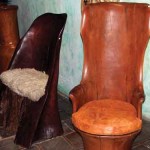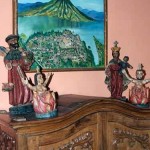Artisty in Wood
text and photos by Ira Lewis
Woodcarving in Guatemala
Guatemala is fortunate to have a long, rich history of artisan/artists working in many media going back to pre-Colonial times. Most of the ancient sculpted art is seen as carved stone. However, some of the less-durable carvings in wood from this era still survive.
We are fortunate that in this plastic, machine-made age, artists in Guatemala still can take a chunk of wood and a few, frequently simple, hand tools and produce items that have to be called art. True, much of the work seen is in the Naïve or Folk Art genre, and some of the offerings are crude souvenirs, but look around and you will find an unusual amount of well carved, beautifully designed pieces that are truly art.
Much of the carved wood items are reproductions from colonial times, ranging from the beautifully executed saints and cherubs with china-doll faces and glass eyes to primitive renderings of these same saints. Furniture, shutters, doors, lintels, kitchen utensils, bowls and other useful articles were frequently decorated with carving. Slingshots (hondas) were not just a forked stick with rubber bands to launch a smooth stone but were carved into fanciful images to suit the owner’s imagination or to bring luck and sure shots.
All these beautifully carved traditional pieces are still being produced because the craft/artistry of fine carving in Guatemala has never stopped. Now, some pieces aimed at the low-end market are carved in series, but they are still carved by hand, one at a time. Unfortunately, there are also pieces made on duplicating machines, seen in some shops or market stalls. Some are not worth the few Quetzales they cost to carry them home, but many others, carved by Guatemalan artisans, are extremely well done, with the same skill and pride of workmanship as they were centuries ago.
In the shops, street stalls and markets catering to tourists one mostly sees renditions of folk art: saints, angels, cherubs, decorative scrollwork, masks and slingshots. Frequently, there are also smaller pieces of carved furniture. When these carvings are well done they can be, and often are, used as decoration in beautiful homes, sitting beside valuable antiques or as a contrast to superb modern furniture and paintings.
To see the finer carving, it is usually necessary to go to an antique store, to the shop of a carver, furniture maker or an art gallery.
In the shops of the carvers, it is possible to request a special carving—some only work on order. For example, a carved name board for your house; yacht; nativity, chandelier, modern or colonial—anything. If it is carved of wood and you can sketch it, these highly skilled carvers can probably carve it better than you can draw.
Cabinetmakers offer beautifully executed wooden furniture carved in designs popular in Europe in the 15th, 16th and 17th centuries. Most will also build cabinets, sofas, chairs, tables—anything you wish—made to order.
If you are a visitor and want something special, order early and be very specific about the date needed. Many can deliver in a surprisingly short time. Obviously, only order from a workshop that produces work of the quality you want, then specify that you will not accept anything that you consider inferior. It is best to order with two or three days’ safety margin unless the piece is very small. Give no more than 15% down payment and the balance on delivery. Check as frequently as possible on progress, and visit the shop a day or so before promised delivery.
Visitors who wish to take any carved wood antiques back to their home country are advised to search for some of the well-done reproductions being produced and get a certificate from the seller that the piece is new and not an antique. It is unlawful to remove authentic colonial antiques and pre-Columbian artifacts from the country.
There are other artists who produce sculptures, both realistic and free form using the beauty, grain and color of wood as their medium. Some truly outstanding pieces are seen in galleries or in the workshops of the artists. Also, there is modern wooden furniture being done with such skill, with such innovative design that it serves both form and function. Other artists collect wood and using the found shape, refine it into a highly decorative piece or a true sculpture. Frequently, this “found wood” is formed into fantastic furniture—decorative, beautiful, and useful.
Very few countries in the world still have this history of fine craftsmanship in wood. Advanced technology, yes. Using a computer to design and a duplicating machine to turn out several copies rapidly, yes. But, the generations-learned skill of using a knife and a chisel with a piece of wood —this skill is disappearing. There are not too many places left in the world where this pride of workmanship still exists. Guatemala is one.
- Woodcarvers Oscar Geovani and Eduardo Reyes create an intricate headboard
- Saint John the Evangelist carved in the 16th or 17th century. The face is painted in skin tones. The robe was probably originally painted and has since been stripped to show the beauty of the natural wood. (Hotel Santo Domingo)
- A bench carved to enhance the original shape of the log, finished in the natural color of the wood showing the grain and visible knots, becomes a piece of furniture, or is it art you can sit on? (The Angelina Gallery)
- Chairs urged from the natural shape of logs with minimal carving and finishing
- An 18th century carving of Saint Dominic in a carved and painted niche. (Hotel Santo Domingo)
- Recently made folk art saints and souls in purgatory, sitting atop an antique armoire framing a naïve art painting by Juan Sisay.







Pingback: Wood Carving in Guatemala | ArteAntigua
Quiero conocer mas de los tallados de madera en Guatemala